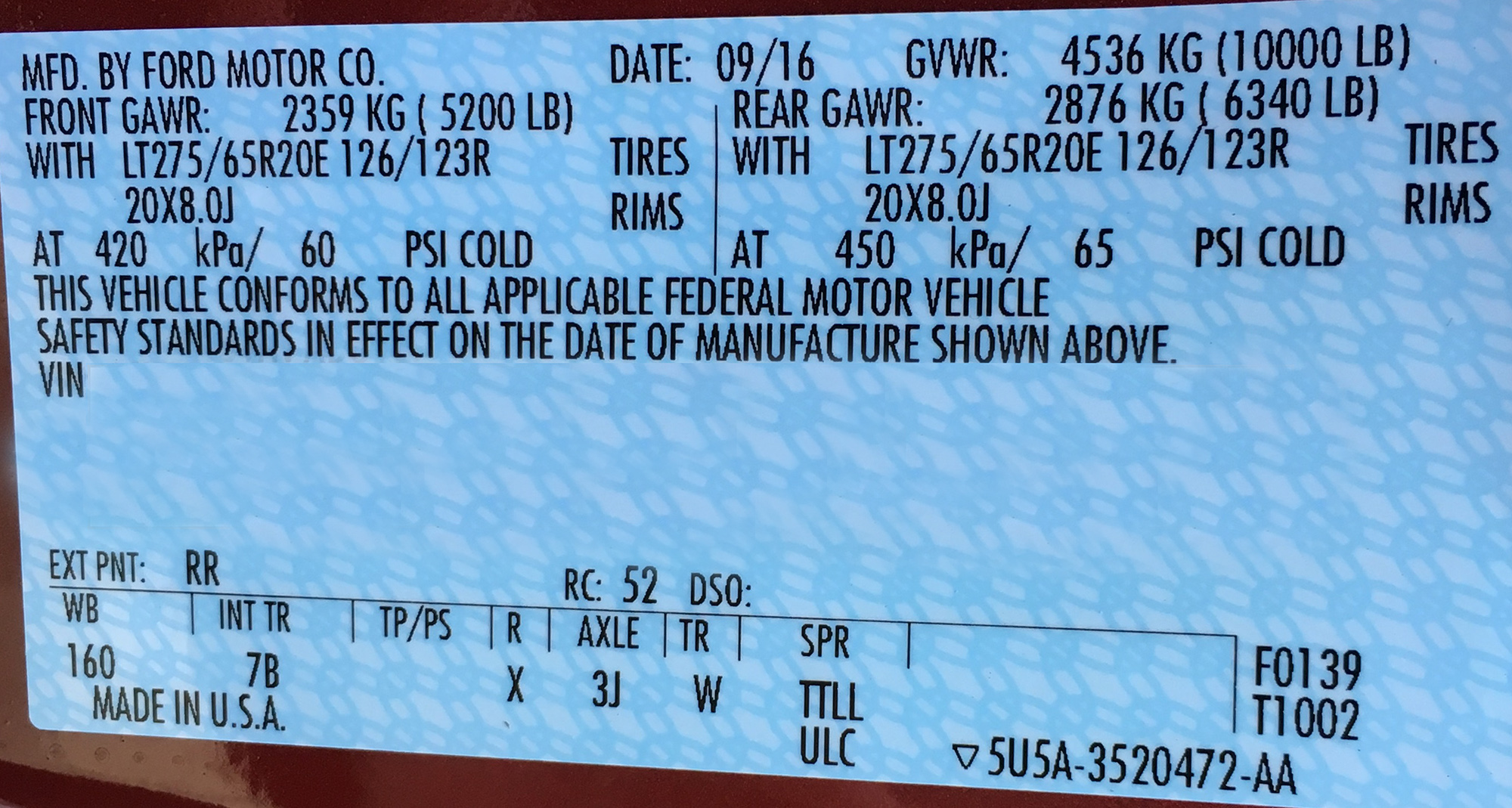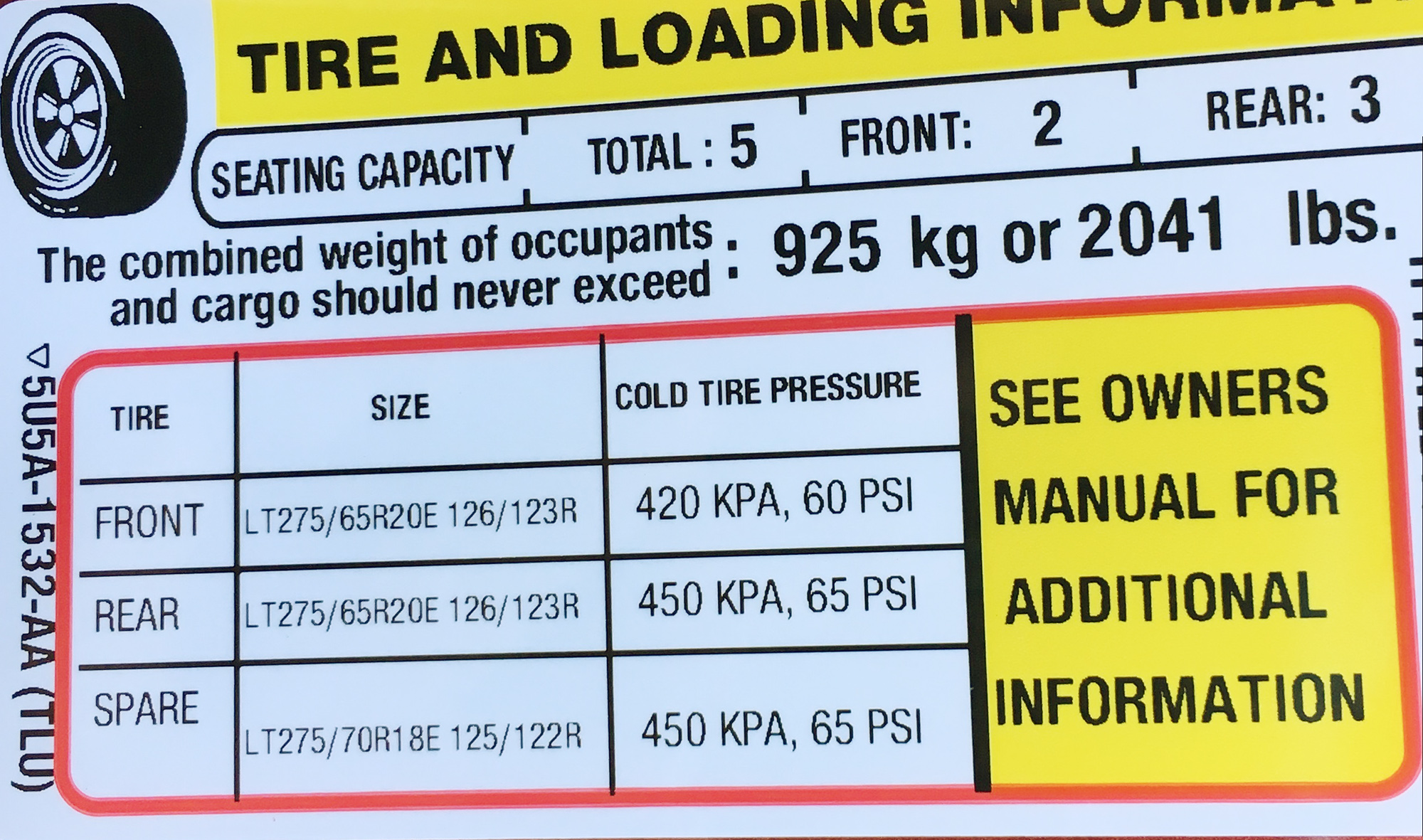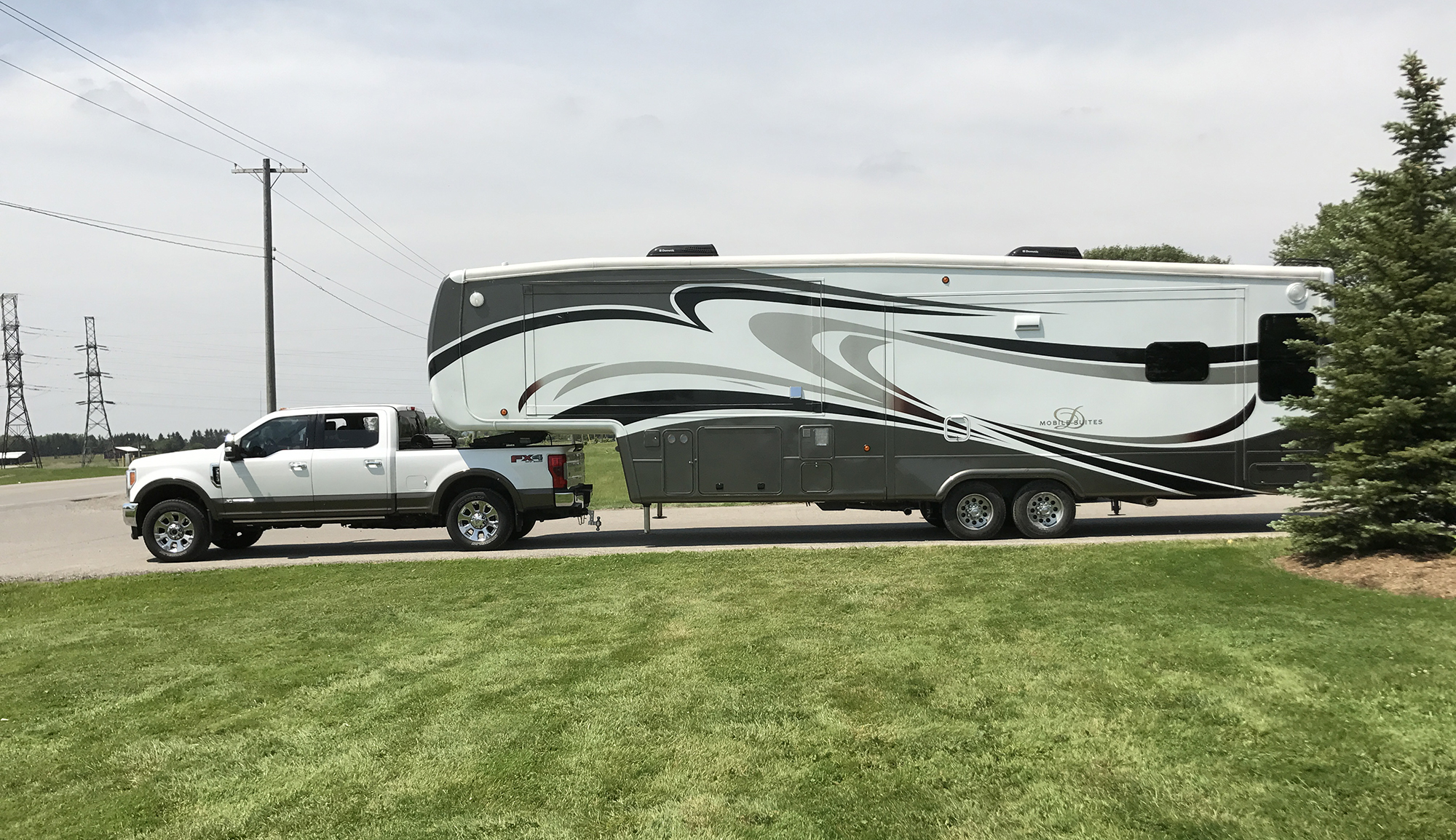Understanding your truck’s door sticker.

Some automakers have started printing payload capacity on the door sticker of new trucks in addition to GVWR and GAWR ratings. The question is: are these payload numbers valid, especially when towing? I’m going to use a Ford for my example here but similar numbers hold true for the other manufacturers.
Recently a client came in concerned about their new F-250 crew cab diesel 4X4 truck. When ordering his truck, the dealer correctly assured him that it would easily handle their 12,000-pound Fifth Wheel as the F-250’s tow rating for Fifth Wheels is 14,700 pounds.
However, when the truck arrived the sticker on the door shows a payload capacity of only 2,041 pounds, which is ridiculously low for a HD truck. Since some Fifth Wheels weigh close to 14,700 pounds, it will definitely put more than 2,000 pounds on the pin, let alone other weight in the truck. So, either the tow rating or the payload number of the customer’s F-250 is not correct.
Over the last 30 years people have towed 14,000 pound Fifth Wheels billions of miles with ¾ ton trucks which were quite similar to today’s trucks. In the 90’s a delivery driver from Kansas who brought us our large NuWa Fifth Wheels had 900,000 miles on his Dodge 2500 and over 50% of those miles were spent towing. It is hard to imagine a more proven track record than that! Since the trucks have such a long-term track record of easily towing 14,000 pound Fifth Wheels you would have to conclude that the tow rating is valid, but something does not make sense with the payload number.
 Forty years ago, trucks were a tool usually operated by people with plenty of mechanical understanding. People like my father, whose first car was a 1931 Model A Ford (the same age as he was). If you did not have mechanical sense and understanding you could not drive.
Forty years ago, trucks were a tool usually operated by people with plenty of mechanical understanding. People like my father, whose first car was a 1931 Model A Ford (the same age as he was). If you did not have mechanical sense and understanding you could not drive.
Back then a truck was an inexpensive unsophisticated tool for transporting stuff, with a regular cab and 8’ box. A 2500 or 250 truck weighed about 4,500 pounds with a GVWR of 7600 so, in theory, they had a payload capacity of 3,100 pounds. However, no one worried about things like payload restrictions, people who used trucks could tell when they were loading too much. The springs would be too low, the tires bulging and they could sense it in the steering, so they would either offload weight or drive slowly.
Then came the law of unintended consequences, in 1975 the U.S. government decided to mandate fuel economy. Each manufacturer’s cars and light trucks had to meet a fuel efficiency standard. Trucks however, did not have to meet as stringent a standard as cars, so as cars got smaller trucks got larger.
People who wanted a large vehicle started buying trucks and large SUVs and over the years trucks became luxury vehicles. The fuel economy standard was very effective at moving people from relatively fuel efficient cars into thirstier trucks and SUVs. Today the largest cars get better fuel economy than the smallest pickups and mid-size SUVs.
In order to be a luxury vehicle, the truck could keep its primitive chassis, but the interior needed sprucing up. Things like a back seat, four doors, more sound deadening to make the vehicle quieter, everyone figures their truck has to be a 4×4 so that had to go in. Then came the diesel engine which was much heavier and needed even more sound insulation, so the trucks became heavier again. All engines became more powerful so the transmissions, transfer cases and axles had to be larger. This also meant bigger brakes, tires and wheels. The outcome of all this meant at one point in the 90’s, you could buy an F-250 that weighed 7,600 pounds with a GVWR of 8,800 lbs. so in theory, only 1,200 pounds of payload. However, at the time no one paid attention to payload numbers everyone just looked at the axle capacities. That method is still what makes the most sense today.
Now, back to this customer’s 2019 F-250. This truck has a front axle capacity of 5,200 pounds and rear axle capacity of 6,340 pounds and its tires are rated to carry 7,500 pounds per axle. In theory, if you could distribute the load perfectly this truck could handle 11,540 pounds without overloading an axle, yet the Gross Vehicle Weight Rating is de-rated to 9,900 pounds.

Some will say this is because if the manufacturer has determined that loading more than 2,041 pounds of payload capacity will cause the truck to be unstable. If you were to put 2,041 pounds in the back of the box and hanging off the trailer hitch it would be.
However, if this same truck had a gasoline instead of a diesel the payload increases by 800 pounds, which is the weight difference of the diesel engine. All of this 800 pound weight difference is going to come off of the front axle of the truck, the additional load will surely be placed on the rear which would certainly change the stability far more. So, it is not a handling issue. It has nothing to do with braking as these trucks have large brakes and tires so they stop very well for a truck.
When loading a solo vehicle, you can place quite a bit of weight behind the rear axle of the truck, which would have the largest effect on handling. However, when towing a fifth wheel you place all the pin weight directly on the rear axle.
Also, when towing a Fifth Wheel in any evasive maneuver the limiting factor is the Fifth Wheel. The Fifth Wheel has a much higher centre of gravity than the truck has so it will roll over long before the truck is close to its handling limits. To put it another way: I could run a 12,000-pound Fifth Wheel through a handling test with a Ford Ranger about as fast as I could with a semi-tractor.
Likely the main driver of the low payload number has nothing to do with the truck’s capability and everything to do with regulatory compliance. Once the GVWR of a truck exceeds 10,000 pounds it is subject to a host of regulations and red tape. The 10,000-pound number was decided upon back when trucks were much lighter, but also without antilock brakes, stability control etc. etc. So even though the trucks have become larger and heavier with far more capability the payload number will be artificially low, it has no bearing on performance or capability just regulatory compliance. In fact, you can spec a F-350 with the GVWR lowered to 9,900 pounds.
So, the question becomes how much pin weight can this truck actually carry safely and reliably? Will it carry their 12,000-pound fifth wheel with 2500 pounds of pin weight? Let’s take a look at the numbers.
Here we can see the F-250 could carry 3,870 pounds of pin weight before exceeding the rear tire capacity. Though that would not be advisable. However, the F-350 will easily handle the same weight and the only difference is a slightly heavier rear axle and one additional leaf in the springs. Now if you decide to go weigh your combination and you discover that your fifth wheel has a rear axle weight of 3,000 pounds and your rear axle is at 6,700 pounds, don’t get too concerned, as there is plenty of tire capacity and the axle components have plenty of overbuild in them. If you can lighten the load in your front storage a little then go ahead but don’t feel you have to rush out and change trucks.
This F-250 will safely and reliably tow their fifth wheel hundreds of thousands of miles if they so choose. I’m sure some people won’t be comfortable exceeding a number that is written down, which is understandable, but their truck may be able to easily tow what they’re asking of it. However, I don’t think it will be very many as I don’t see many driving 100 KPH on the 401.























